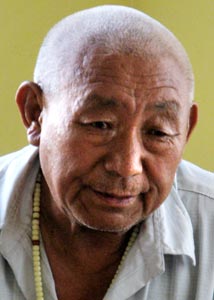Name: Tsondue Gyaltsen
(Alias: No)
Gender: Male
Interview Age: 74
Date of Birth: 1936
Birthplace: Digung, Utsang, Tibet
Year Left Tibet: 1959
Profession: Monk
Monk/Nun: Previously
Political Prisoner: No

Interview No.: 15M
Date: 2010-04-07
Language: Tibetan
Location: Doeguling Settlement, Mundgod, Karnataka, India
Categories: Culture and History
Keywords: customs/traditions, death/burial customs, festivals, March 10th Uprising, medical treatment, monastic life, taxes, Utsang
Summary:
Tsondue Gyaltsen's birthplace Digung Thashoe was a distance of three to four hours by vehicle from Lhasa. The most unique part of his village was that it was surrounded by a fence with gates in the east and west. His family was engaged in farming and paid taxes to the Digung Monastery and the Tibetan government based on the family's wealth. He elaborates on the two types of taxes and how they were paid.
Tsondue Gyaltsen describes the monks called tsam-pa 'meditators' and their role in the life of the local villagers. Tsondue Gyaltsen became a monk at the age of 13 and joined Gaden Monastery near Lhasa. He provides a vivid description of an epidemic which claimed the lives of many young people, including a large number of monks. He was able to escape death during the epidemic as a result of an unusual remedy provided by his teacher.
Tsondue Gyaltsen explains in length about the death ritual of chadhor in which dead bodies were dissected and fed to the vultures. This was the preferred method of burial except in the case of death by disease when bodies were buried instead of sky burial during the epidemic.
Tsondue Gyaltsen witnessed the bombing of Lhasa by the Chinese in 1959. He wanted to join the Chushi Gangdrug [Defend Tibet Volunteer Force] but was too late and escaped into India.
Interview Team:
- Marcella Adamski (Interviewer)
- Pema Tashi (Videographer)
- Namgyal Tsering (Interpreter)

